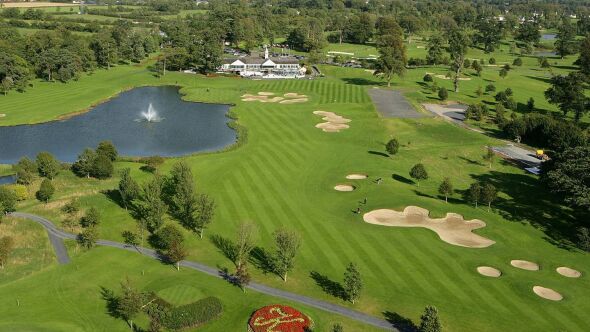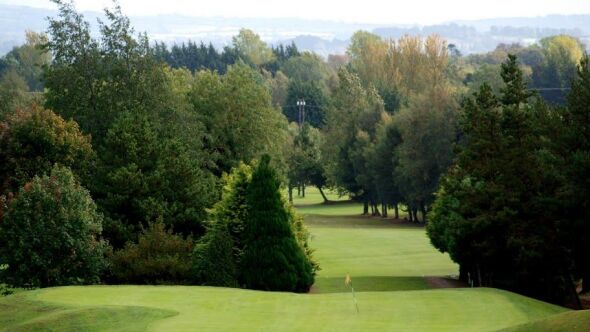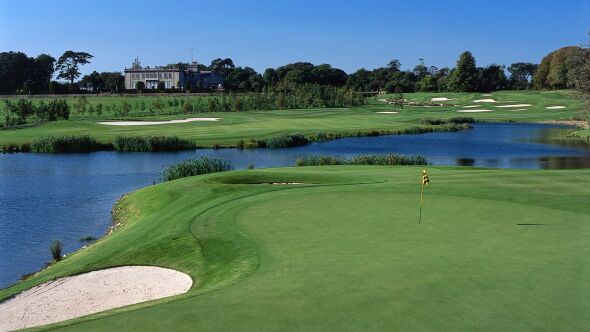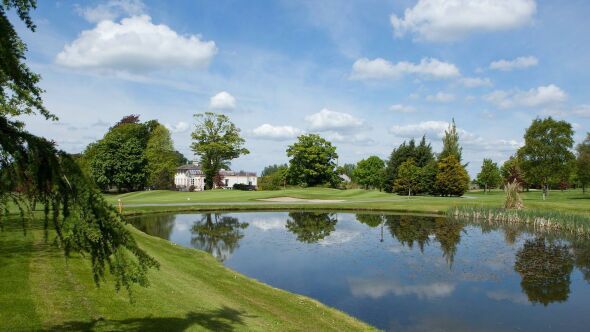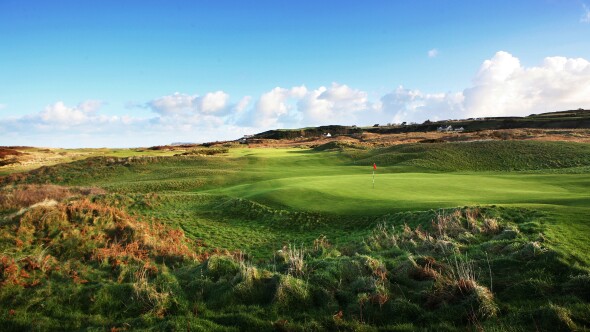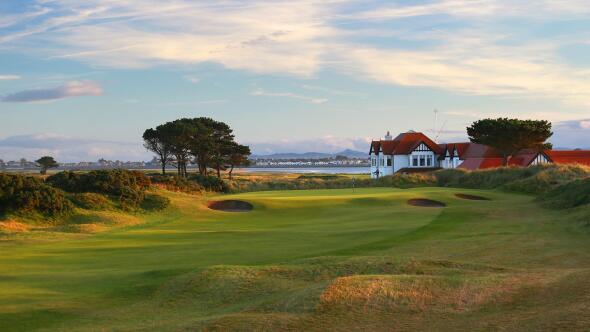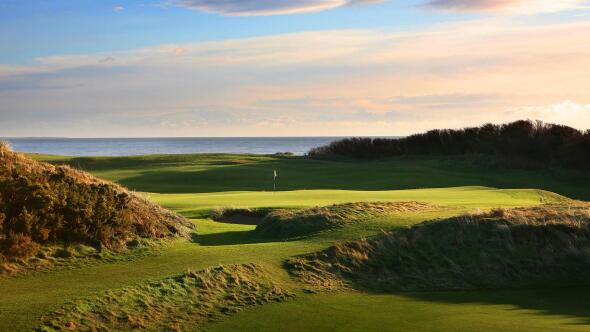The K Club - The Palmer North Course

About
| Tee | Par | Length | Rating | Slope |
|---|---|---|---|---|
| Blue | 72 | 7350 yards | ||
| White | 72 | 6815 yards | ||
| Green | 72 | 6240 yards | ||
| Red | 73 | 5131 yards |
| Hole | 1 | 2 | 3 | 4 | 5 | 6 | 7 | 8 | 9 | Out | 10 | 11 | 12 | 13 | 14 | 15 | 16 | 17 | 18 | In | Total |
|---|---|---|---|---|---|---|---|---|---|---|---|---|---|---|---|---|---|---|---|---|---|
| Blue M: 76.1/138 | 581 | 429 | 182 | 431 | 214 | 452 | 596 | 422 | 452 | 3759 | 417 | 412 | 172 | 568 | 445 | 483 | 434 | 177 | 546 | 3654 | 7413 |
| White M: 73.7/133 | 558 | 396 | 176 | 386 | 199 | 418 | 560 | 366 | 420 | 3479 | 400 | 400 | 161 | 545 | 406 | 418 | 394 | 160 | 527 | 3411 | 6890 |
| White/Green M: 72.6/131 | 558 | 379 | 176 | 386 | 188 | 418 | 528 | 330 | 420 | 3383 | 364 | 400 | 145 | 517 | 406 | 392 | 394 | 160 | 487 | 3265 | 6648 |
| Green M: 71.5/128 W: 78.1/140 | 539 | 379 | 149 | 348 | 188 | 390 | 528 | 330 | 394 | 3245 | 364 | 371 | 145 | 517 | 378 | 392 | 370 | 160 | 487 | 3184 | 6429 |
| Red M: 66.4/113 W: 71.6/126 | 410 | 303 | 135 | 291 | 154 | 321 | 491 | 295 | 373 | 2773 | 302 | 293 | 114 | 458 | 317 | 317 | 305 | 137 | 451 | 2694 | 5467 |
| Handicap | 6 | 12 | 18 | 8 | 16 | 10 | 2 | 14 | 4 | 9 | 3 | 17 | 11 | 7 | 5 | 1 | 15 | 13 | |||
| Par | 5 | 4 | 3 | 4 | 3 | 4 | 5 | 4 | 4 | 36 | 4 | 4 | 3 | 5 | 4 | 4 | 4 | 3 | 5 | 36 | 72 |
| Handicap (W) | 8 | 12 | 18 | 6 | 16 | 4 | 2 | 10 | 14 | 11 | 13 | 17 | 5 | 3 | 9 | 1 | 15 | 7 |
Course Details
Rentals/Services
Practice/Instruction
Policies
Food & Beverage
Bar, RestaurantLodging
Lodging AvailableAvailable Activities
Fishing, RidingAvailable Sports
TennisReviews
Reviewer Photos
-
Photo submitted by u314161567894 on 05/31/2021
-
Photo submitted by noahjurik on 04/12/2019
-
Photo submitted by noahjurik on 04/12/2019
-
Photo submitted by noahjurik on 04/12/2019
-
Photo submitted by noahjurik on 04/12/2019
-
+ 4 morePhoto submitted by noahjurik on 04/12/2019
-
Photo submitted by noahjurik on 04/12/2019
-
Photo submitted by noahjurik on 04/12/2019
-
Photo submitted by noahjurik on 04/12/2019
-
Photo submitted by noahjurik on 04/12/2019
I liked it so much I joined
On A beautiful warm but breezy day I played the Straffan Club (ex Smurfit).
Testing but fair with some lovely features on most holes. Not a tough walk and I’m great condition. Greens were fair and pretty fast.
Loads of bunkers on the front and plenty of water on the back.
The lads in the clubhouse were very good and accommodating.
Great day and I am now looking to join.
Extremely unique
The Smurfit Course at the K Club is one of the more unique golf experiences I’ve had. It’s kind of a bizarre mix between a manufactured links course and a water-filled parkland course. It works on some levels, but on others it feels contrived and disorienting. You definitely have the sense you’re playing on something man-made. It’s still a fun course to play, but I had a feeling hanging over me the whole round.
It’s a relatively easy walk and there are some gorgeous views and well designed holes, despite all the other stuff. It’s also very well manicured, as you’d expect from the K Club. I’m glad I played it while staying on property. I wouldn't go out of my way to play it, but if I was in the area I would. You have to see it to understand its uniqueness!
Good course but slightly unmemorable
The Palmer Course at the K Club is a difficult test. It’s a beautiful golf course that meanders around the massive hotel and the river on property. Conditioning was very good and the staff was accommodating. The layout is good, but I wouldn't say it's the most exiting or different thing I've played. There are some memorable holes, but some seem to blend together. It’s a very American course, which may not be exactly what you’re looking for in Ireland, but it’s still a lot of fun to play where the professionals do. I wouldn’t say it’s extraordinarily above average, but it’s an entertaining resort course and I’m glad I played it while staying on property. Unless resort/parkland golf is what you want to play in Ireland, I’d opt for some century old links experiences instead.
Excellent Parkland Layout
Today was the start of the serious golf with a late morning start at the K Club - Palmer Course, the venue of the 2006 Ryder Cup. This was to be the only non links course on the tour and is a beautiful parkland style setting. The place oozes class from the minute you turn into the property, a huge accommodation hotel, spacious locker rooms and lovely clubhouse.
The course was in superb condition with fairways manicured within an inch of their life. The fairways were reminiscent of Metropolitan without the hardness and roll we get in Melbourne. The weather gods finally transpired to toss some sleety showers that were with us the entire back nine which made things that little bit tougher.
I have a bit of an issue with courses that have an over reliance on water (creeks, lakes etc) as a central defence of the course and this kind of falls in that category with water present on more than half of the holes. Having said that there is plenty of room and it stands up as a reasonably fair course.
Would I call it a great course? No. For mine there aren't a lot of holes that I recall as having any WOW factor but the finishing three are strong. the par 3's didn't really hit my go button and are perhaps better holes played from the tips. It is the sort of course that you would play much better the second time after working out correct lines off the tees.
Fantastic experience
Why so few persons to play? Is possible the prive high
great value for money
We played a 3 ball on Sunday 2nd Feb and only had to pay.49 euro per person this was fantastic value and even though we have had some very heavy rain lately the course was in excellent condition.
We will definitely be looking for similar deals at the K club again.
Excellent golf course with history
I highly recommend K Club. It is a plasure to play such a good golf course. Narrow fairways and a lot of water hazard on the back nine makes Palmers Course quite challenging.
Good Course
Lovely linksy type parkland course. Good greens and some tricky fairways
Terrific Course!
The Smurfit course was in great shape. I consider it to be a far superior course than the Palmer course. The staff was extraordinarily friendly and welcoming. We asked for a buggy but even though they didn't have one, they made every effort to have one for us on the turn after our 9th hole. The Pro Shop is equipped with lots of items and even though expensive, this isn't a course we play every day so it was worth it to buy some items. The finishing hole is tough but fair. Be mindful of the wind when taking out a club. Overall, a very fair test of golf and with the friendly staff, I highly recommend this course at the golfnow discount rates!
fantastic
Changing our annual golf to k club as it was so great.worth every penny.highly highly recommended
Good value but Palmer course better
Played smurfit at end of may 2013, good value at 37 euro. Weather was sunny but breezy making for tough scoring, nice course especially last six holes, general condition was good but could do with bit more work. Greens were good however, overall worth up to 40 euro, not quite as good as the sister Palmer course but cheaper :-)















